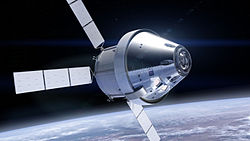Orion (spacecraft)
 |
|
|---|---|
| Description | |
| Role: | Beyond LEO spacecraft. |
| Crew: | 2–6 |
| Launch vehicle: |
Space Launch System,
Delta IV Heavy (Exploration Flight Test 1), Ares I (canceled) |
| First launch: | December 5, 2014 (uncrewed test launch) |
| Dimensions | |
| Height: | Approximately 3.3 m (11 ft) |
| Diameter: | 5 m (16 ft) |
| Pressurized volume: | 19.56 m3 (691 cu ft) |
| Habitable volume: | 8.95 m3 (316 cu ft) |
| Capsule mass: | 10,387 kg (22,899 lb) |
| Service Module mass: | 15,461 kg (34,086 lb) |
| Total mass: | 25,848 kg (56,985 lb) |
| Service module propellant mass: | 9,276 kg (20,450 lb) |
| Performance | |
| Total delta-v: | ~1,340 m/s (4,400 ft/s) |
| Endurance: | 21.1 days |
| Extra Modules | Asteroid Redirect Vehicle, Habitat Module,etc. |
Delta IV Heavy (Exploration Flight Test 1),
Ares I (canceled)
The Orion Multi-Purpose Crew Vehicle (Orion MPCV) is an American spacecraft intended to carry a crew of four astronauts to destinations at or beyond low Earth orbit (LEO). Currently under development by NASA for launch on the Space Launch System, Orion is intended to facilitate human exploration of asteroids and of Mars and to retrieve crew or supplies from the International Space Station if needed.
The Orion MPCV was announced by NASA on May 24, 2011, and is currently under development. Its design is based on the Orion Crew Exploration Vehicle from the cancelled Constellation program. It has two main modules. The Orion command module is being built by Lockheed Martin at the Michoud Assembly Facility in New Orleans. The Orion Service Module, provided by the European Space Agency, is being built by Airbus Defence and Space.
The MPCV's first test flight (uncrewed), known as Exploration Flight Test 1 (EFT-1), was launched atop a Delta IV Heavy rocket on December 5, 2014, on a flight lasting 4 hours and 24 minutes, landing at its target in the Pacific Ocean at 10:29 Central (delayed from the prior day due to technical and weather problems). The first mission to carry astronauts is not expected to take place until 2023 at the earliest, although NASA officials have said that their staff is working toward an "aggressive internal goal" of 2021. However, a July 2016 Government Accountability Office report cast doubt on even the 2023 launch date, suggesting it may slip up to 6 months. The report gave only a 40% confidence in the 2021 launch date, and suggested the aggressive goal may be counterproductive to the program.
...
Wikipedia
